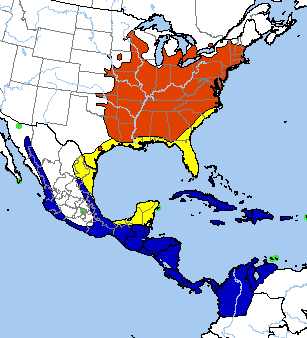Birdfinding.info ⇒ Uncommon and local, but its consistent preference for clear-running woodland streams and the loudness of its song make it fairly predictable to locate during its breeding season—mainly April and May—in forested hills of the interior of the eastern U.S. (see Breeding Bird Survey Abundance Map in Notes, below).
Louisiana Waterthrush
Parkesia motacilla
Breeds in the eastern U.S. and southernmost Canada. Winters from Mexico to northern South America and the West Indies.
Breeding. Mainly deciduous forests in close proximity to flowing water. From southeastern Minnesota eastward through the Great Lakes to southwestern Maine, and south to central Texas and the Florida Panhandle.
Nonbreeding. Winters mainly in streamside woods in the foothills of both slopes of Mexico and Central America from Sonora (sparingly into Arizona) and Nuevo Leon south to Panama, and on Cuba, Jamaica, Hispaniola, and Puerto Rico. Also found in small numbers elsewhere in the Caribbean basin, including the Bahamas, Cayman Islands, Virgin Islands, and the Caribbean slopes of Colombia and Venezuela.
Movements. Migrates remarkably early in both spring and fall—it has the earliest migration clock of all North American warblers. Arrives on breeding grounds from mid-March into April. Departs from mid-June into July, returning to its winter quarters in August and September.
Identification
One of two very similar species of largely terrestrial wood warblers with thrushlike plumage, a peculiar tail-bobbing gait, and a strong proclivity for wet habitats.
Louisiana Waterthrush is recognized by its bright white eyebrow, pale pink legs, unstreaked throat, sparsely streaked underparts, and faint buffy or pinkish wash on its flanks. (See below for more detailed information on separating Northern and Louisiana Waterthrushes.)
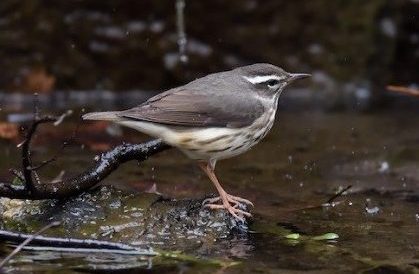
Louisiana Waterthrush—note pink legs, faintly buffy flanks, and white eyebrow that broadens behind the eye. (Central Park, New York; April 10, 2018.) © Terence Zahner
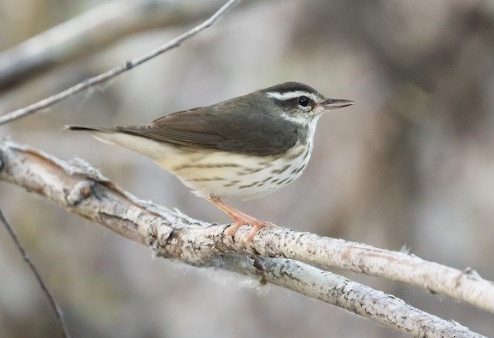
Louisiana Waterthrush, far out of its normal range—note pink legs, white eyebrow, faintly buffy flanks, and sparsely streaked underparts. (Ketchum, Idaho; July 16, 2018.) © Darren Clark
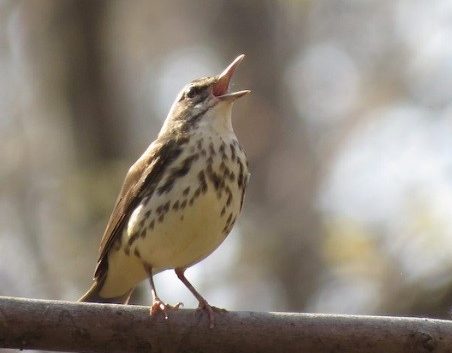
Louisiana Waterthrush—note unstreaked throat and limited extent of streaking on underparts. (Flat Creek Boardwalk, Peachtree City, Georgia; March 21, 2017.) © Michelle Hamner

Louisiana Waterthrush—note pink legs and unstreaked throat. (Patapsco Valley State Park, Howard County, Maryland; April 19, 2018.) © Anthony VanSchoor
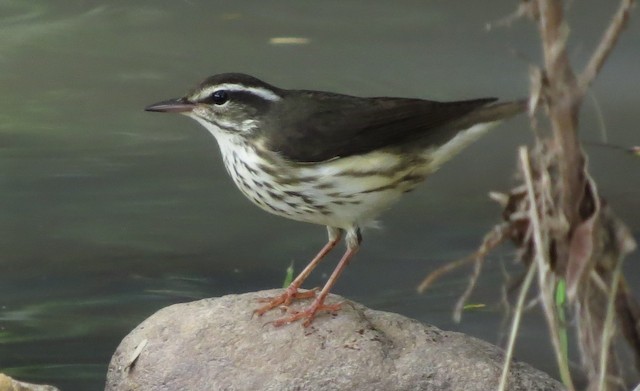
Louisiana Waterthrush, with typical amount of streaking on underparts—also note pink legs, buffy flanks, and unstreaked throat. (Zamorano University, Francisco Morazán, Honduras; September 10, 2017.) © Oliver Komar
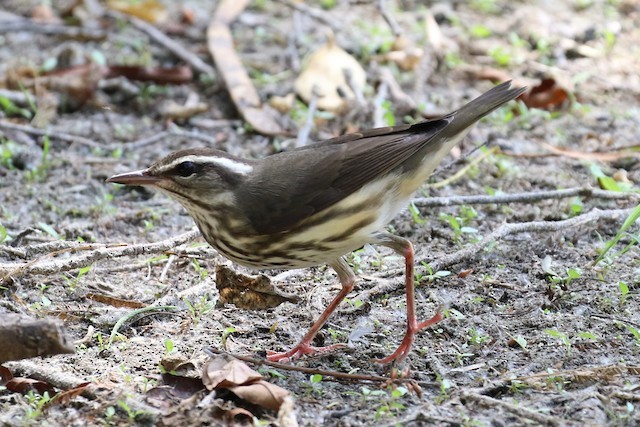
Louisiana Waterthrush, with atypical boldly streaked underparts—but note pink legs, buffy flanks, and white eyebrow that broadens behind the eye. (Frontera Audubon Center, Weslaco, Texas; July 25, 2016.) © Dan Jones
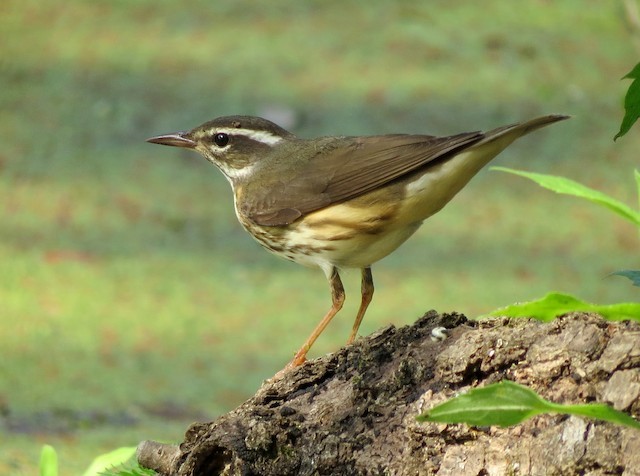
Louisiana Waterthrush—note pink legs, buffy flanks, and white eyebrow that broadens behind the eye. (Sabine Woods, Texas Point National Wildlife Refuge, Texas; March 26, 2017.) © John Mariani
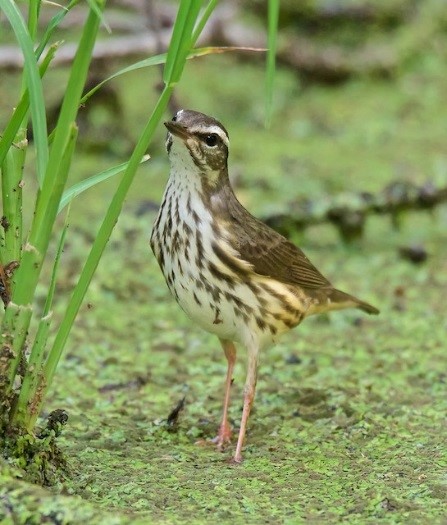
Louisiana Waterthrush—note pink legs, buffy flanks, and mostly unstreaked throat. (Sabine Woods, Texas Point National Wildlife Refuge, Texas; April 27, 2017.) © Harlan Stewart
Cf. Northern Waterthrush. The two waterthrush species overlap widely during most of the year, and can be challenging to distinguish when not singing. Each has several distinctive traits, but both species are variable and some individuals are more intermediate than other. In many cases, identification requires multiple factors.
Following are the typical differences, but note that there is some overlap on every characteristic:
Eyebrow: Louisiana’s eyebrow is typically pure white and usually broadens behind the eye. Northern’s eyebrow is usually dingy white or yellowish and highly variable in extent—behind the eye it may either narrow or broaden or neither.
Legs: Louisiana’s are pale pink—often bright, “bubblegum” pink. Northern’s are usually grayish or dull pink, but can also be pale pink.

Northern Waterthrush—note mid-sized bill, even width of eyebrow, dark gray legs, and bold, sharp streaking on underparts. (Criadero de Cocodrilos, Matanzas, Cuba; February 13, 2017.) © Paul Tavares
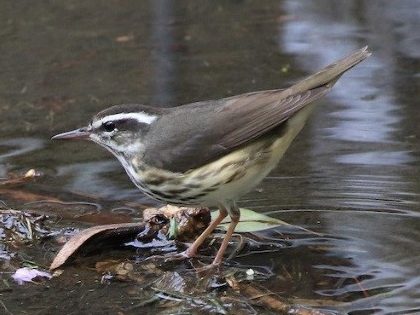
Louisiana Waterthrush—note long bill, broadening white eyebrow, pale pink legs, and diffuse streaking on underparts. (Gilman Park, Fullerton, California; September 16, 2017.) © Trish Gussler
Bill: Louisiana’s bill averages longer than Northern’s. This difference is difficult to assess in the field, usually most noticeable on long-billed individuals.
Throat: Louisiana’s throat is mostly unmarked, sometimes with a few speckles. Northern’s is streaked or speckled, often heavily.
Coloration of Underparts: Louisiana is mostly whitish below with a variable buffy or salmon-pinkish wash on the flanks. Northern’s underparts are usually the same color throughout, either whitish or yellowish.

Northern Waterthrush—note mid-sized bill and short, tapering eyebrow—but this individual also has pale pink legs and buffy flanks with somewhat diffuse streaking. (Falmouth, Jamaica; January 31, 2019.) © Matthew Grube

Louisiana Waterthrush—note long bill, buffy flanks, pink legs, and diffuse streaking on underparts—but its eyebrow is intermediate. (Sabine Woods, Texas Point National Wildlife Refuge, Texas; March 28, 2016.) © Harlan Stewart
Streaking on Underparts: The quantity and quality of streaking on the underparts is a highly variable characteristic—but it is diagnostic in many cases. As a rule, Louisiana is more sparsely streaked over a more limited area—mainly on the chest and sides—whereas Northern is densely streaked over most of its underparts, including much of the belly. The streaks on Northern are mostly bold, dark, and sharply defined, whereas Louisiana’s are comparatively diffuse (blurry), especially on the sides and flanks.
Tail-bobbing: Louisiana swings its tail in three dimensions. Northern teeters vertically.
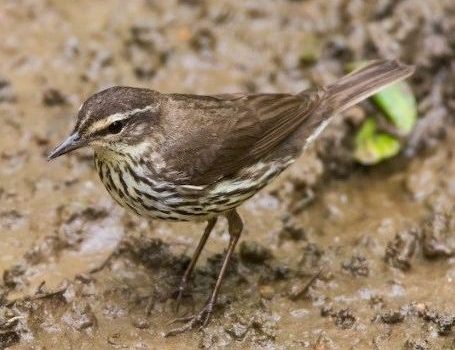
Northern Waterthrush—note tapering eyebrow, dark legs, and extensive bold, sharp streaking on underparts—but this individual appears to have an unstreaked throat. (Luria Park, Annandale, Virginia; May 6, 2018.) © Beth Fedorko
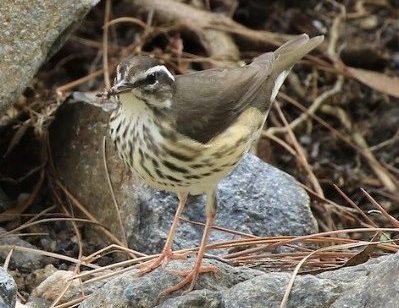
Louisiana Waterthrush—note bold white eyebrow, unstreaked throat, pink legs, and buffy flanks with diffuse streaks. (Gilman Park, Fullerton, California; September 16, 2017.) © Trish Gussler
Habitat: Louisiana favors running water, especially on its breeding grounds, but it also occur beside lakes and in swamps, especially on migration and winter grounds. Northern favors swamps, bogs, and lakeshores, but also occurs beside streams, and is sometimes found in dry habitats—where it often finds tiny rain puddles or patches of moist soil. On the wintering grounds, Northern is far more likely to be found in mangroves.
Among the many characteristics that can be used to identify waterthrushes, several are close to 100% diagnostic when clearly present. For example, any waterthrush with either dark gray legs, a tapering eyebrow, or a streaked throat is certainly Northern. Any waterthrush with a bright white eyebrow that broadens behind the eye, a noticeably long bill, or a salmon-buffy wash on the flanks is almost certainly Louisiana.
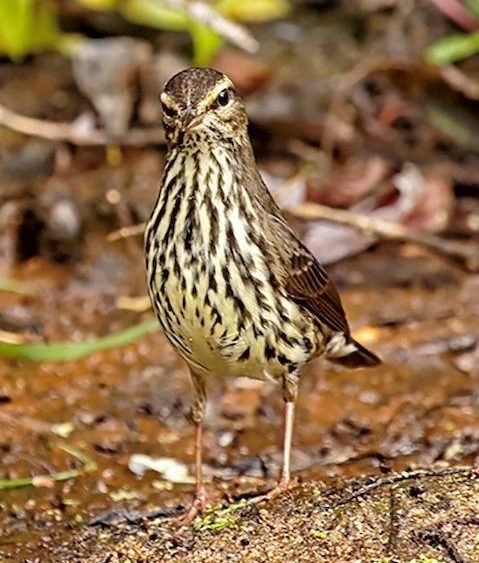
Northern Waterthrush, with heavily streaked underparts, including throat, and generally yellowish coloration of the underparts. (Carmel River mouth, Monterey, California; September 20, 2017.) © Bill Hill

Louisiana Waterthrush, with sparsely streaked underparts, mostly unstreaked throat, and faintly buffy flanks. (Sabine Woods, Texas Point National Wildlife Refuge, Texas; April 27, 2017.) © Harlan Stewart
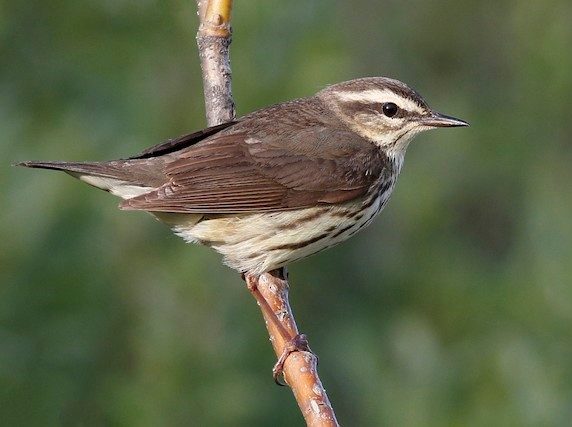
Northern Waterthrush, with pink legs, unusually broad whitish eyebrow, unstreaked throat, and somewhat diffuse streaking on flanks—generally resembling Louisiana—but note short bill and far northern location. (Nome, Alaska; June 9, 2016.) © Laura Keene
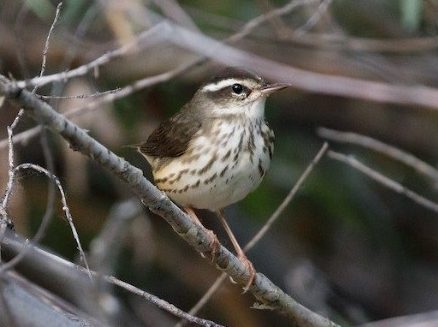
Louisiana Waterthrush, in Idaho, far out of its normal range—note broad white eyebrow, pink legs, buffy flanks, limited streaking on underparts, and unstreaked throat. (Ketchum, Idaho; July 16, 2018.) © Darren Clark

Northern Waterthrush, with pale pink legs, very limited speckling on throat, and intermediate streaking on underparts—but note yellowish coloration of underparts and eyebrow. (Sussex, Delaware; September 10, 2016.) © Bob Edelen
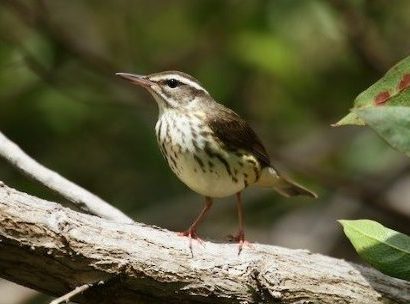
Louisiana Waterthrush, at an unusual location for mid-April—but note very long bill. (Charles “Sonny” McCoy Indigenous Park, Key West, Florida; April 19, 2017.) © Patrick J. Blake
Notes
Monotypic species.
References
Alderfer, J., and J.L. Dunn. 2014. National Geographic Complete Birds of North America (Second Edition). National Geographic Society, Washington, D.C.
Ascanio, D., G.A. Rodriguez, and R. Restall. 2017. Birds of Venezuela. Christopher Helm, London.
Dunn, J.L., and K.L. Garrett. 1997. A Field Guide to Warblers of North America. Houghton Mifflin, Boston.
eBird. 2019. eBird: An online database of bird distribution and abundance. Cornell Lab of Ornithology, Ithaca, N.Y. http://www.ebird.org. (Accessed March 16, 2019.)
Fagan, J., and O. Komar. 2016. Peterson Field Guide to the Birds of Northern Central America. Houghton Mifflin Harcourt, New York.
ffrench, R. 2012. A Guide to the Birds of Trinidad & Tobago (Third Edition). Cornell University Press, Ithaca, N.Y.
Garrido, O.H, and A. Kirkconnell. 2000. Field Guide to the Birds of Cuba. Cornell University Press, Ithaca, N.Y.
Garrigues, R., and R. Dean. 2014. The Birds of Costa Rica: A Field Guide (Second Edition). Cornell University Press, Ithaca, N.Y.
Howell, S.N.G., and S. Webb. 1995. A Guide to the Birds of Mexico and Northern Central America. Oxford University Press, Oxford.
Latta, S., C. Rimmer, A. Keith, J. Wiley, H. Raffaele, K. McFarland, and E. Fernandez. 2006. Birds of the Dominican Republic and Haiti. Princeton University Press, Princeton, N.J.
McMullan, M., and T. Donegan. 2014, Field Guide to the Birds of Colombia (Second Edition). Fundación Proaves de Colombia, Bogotá.
Raffaele, H. 1989. A Guide to the Birds of Puerto Rico and the Virgin Islands. Princeton University Press, Princeton, N.J.
Raffaele, H., J. Wiley, O. Garrido, A. Keith, and J. Raffaele. 1998. A Guide to the Birds of the West Indies. Princeton University Press, Princeton, N.J.
Ridgely, R.S., and P.J. Greenfield. 2001. The Birds of Ecuador, Volume II: Field Guide. Cornell University Press, Ithaca, N.Y.
Ridgely, R.S., and J.A. Gwynne. 1989. A Guide to the Birds of Panama (Second Edition). Princeton University Press, Princeton, N.J.
Ridgely, R.S., and G. Tudor. 2009. Field Guide to the Songbirds of South America: The Passerines. University of Texas Press, Austin.
Salt, W.R., and J.R. Salt. 1976. The Birds of Alberta. Hurtig Publishers, Edmonton, Alberta.
Schulenberg, T.S., D.F. Stotz, D.F. Lane, J.P. O’Neill, and T.A. Parker. 2007. Birds of Peru. Princeton University Press, Princeton, N.J.
Wells, J.V., and A.C. Wells. 2017. Birds of Aruba, Bonaire, and Curaçao. Cornell University Press, Ithaca, N.Y.

